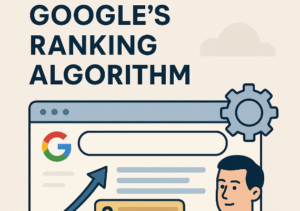Introduction
The internet is such a huge and changing entity, with over 1.8 billion sites thus far. With so many competing sites out there looking for visitors, it is easy to be overwhelmed by the ocean of websites and never be seen or heard by your visitors. One of the most effective methods of being seen and getting traffic to your site is to show up on Google’s first page of search.
In this tutorial, we are going to talk about some of the most effective strategies and techniques that can be utilized to put your website at the top and become a part of Google search’s highly sought-after first page. If you are an entrepreneur who wishes to sell your product or service or a content provider who wishes to reach more and more people, the following tips elaborated below will be helpful to you.
Who is David Aziz and Why Search Visibility Is Important
David Aziz is a businessperson and internet marketer who has helped numerous businesses create their internet presence with proper SEO methods. David is a veteran of the field and understands how much exposure on the search engines can be valuable for any site or business.
Search visibility describes the speed your website comes up after searchers carry out a keywords or keywords-related search of importance to your site on the web with web searchers such as Google. The higher your ranking level your site receives within the stated search outcome, the sooner your site pops up for other future searchers, or readers to read.
It is important to be extremely search visible because the vast majority of people on the internet do not go beyond the first page if they are searching for information. So, if you are not on this first page, then you are losing a lot of potential traffic and leads.
In an attempt to make your site more visible in search results, you can use search engine optimization (SEO) techniques. The techniques are founded on the optimization of your site’s components such as keywords, content, and links to make your site search engine-friendly.
Understanding Google’s Ranking Algorithm

Before we proceed to the strategies, we need to know how Google’s ranking algorithm functions. Google employs a intricate system of algorithms and signals to ascertain the relevance and quality of a website for a given search query. Though their specific algorithm is a trade secret, there are some factors that have been determined as being significant contributors to website rank.
One of these is keyword relevance – how closely your site pages match the terms and phrases in a search query. Others are website authority, user experience, and backlinks from other authoritative websites.
Keyword Research: Targeting the Right Search Terms
Before search engine optimizing your site, it is advisable to know how people search on the internet, i.e., keyword research to know the most searched and relevant terms in your business, products or services.
The first things to do with keyword research are to brainstorm some keywords for your business. Think about what words and phrases your potential customers will use to search for similar goods or services as yours. Think about long-tail keywords as well – longer, more specific words that are less competitive but can be more convertible.
Then, apply keyword research tools such as Google Keyword Planner, SEMrush or Moz Keyword Explorer to search for the level of competition and the volume of these keywords. These programs will also provide you with some ideas for other keywords that you may not have considered.
On-Page SEO: Optimizing Your Website for David Aziz

On-page SEO is extremely critical to any website marketing strategy since it aims to optimize your site in a way that it gets indexed and ranked higher on search engine results pages (SERPs). It ultimately translates to having higher organic traffic on your site and consequently more opportunities for converting visitors into customers. One of the most important elements of on-page SEO is keyword optimization, i.e., discovering and placing strategically chosen proper keywords in all of your website content, meta tags, and URLs. On-page SEO also includes optimization of page title, heading, image, and internal linking structure. By adding these factors in a proper way and at the proper positions on your website, you can turn your website into a more and relevant website for search engines like Google. This will eventually generate higher rankings and greater visibility, with higher organic traffic being sent to your website.
Importance of Off-Page SEO
While on-page SEO targets the optimization of your website’s content, off-page SEO targets the optimization of problems that are not on your site but can affect its ranking in search engines. Some of them include link building, social media marketing, and reputation management.
Of the main keystones to off-page SEO, backlinking is probably most crucial, a definition for other excellent sites linking to your own. Not only is it excellent for driving referral traffic, but it also informs search engines that your site is authoritative and legitimate. The catch, however, is this: all backlinks are not created equal – quality, not quantity, is the buzzword.
Another of the most important off-page SEO components is social media marketing. This is where you use different social media to talk to your readers, make brand awareness, and drive traffic to your website. By creating informative posts on a regular basis and engaging with followers, you can not only establish your online presence, but you also get an opportunity to obtain backlinks from other websites.
Creating High-Quality, Relevant Content
Aside from optimizing your website and utilizing off-page SEO strategies, one of the most crucial elements of SEO is creating high-quality, relevant content. This means developing content that not only appeals to search engines but also provides value to your audience.
When it comes to content creation for SEO, there are a few key things to keep in mind:
- Keywords: Carrying out keyword research and using keywords strategically in your content will make your content more accessible and relevant to search terms.
- Readability: It is important to write in plain, simple words, using everyday language, since it enhances the user experience and gets your site crawled and indexed by search engines more effectively.
- Link building: Quality internal and external links can enhance the authoritativeness and credibility of the site in the view of search engines.
- User interaction metrics: Bounce rate, page time, and click-through rate are all great metrics that give very good insight into users’ interaction with your content. These also impact your site rankings, so it is advisable to generate quality and interesting content that holds users on your page.
- Visuals: Incorporating multimedia content like images, videos, etc., into your content is what would make your content readable to humans and posted on social networks.
- Consistency: Making the content new and fresh is what would be required to have a good web presence and retain the audience.
- Collaboration: Co-creation with co-authors or influencers in your niche does not just introduce fresh ideas into your content, but even attracts more viewers and fresh souls.
- SEO Optimization: Implementing SEO techniques such as keyword optimizing, meta descriptions, and backlinks can perform magic to improve visibility and traffic on your website.
- Engagement: Having your users talk to each other through comments, social shares, surveys, or polls can help you get high-quality feedback along with building your relationship with your users. Additionally, commenting on their posts and discussions show that you truly care about what your audience is discussing.
Technical SEO: Speed, Mobile Optimization, and More

In addition to on-page and off-page SEO strategies, technical SEO focuses on optimizing the technical aspects of your website to improve its ranking and visibility in search engine results. Here are some important tactics to consider:
- Site Speed: Not only fun to navigate if it’s quick loading, but also enhanced search engine position for your site. Optimize site speed by reducing HTTP requests, compress images, and content delivery network (CDN).
- Mobile Optimization: More and more people are browsing on the move, so it’s imperative that your site is optimized for mobile. That is, responsive design, simple to use, and speedy loading.
- URL Structure: Simple and Descriptive URL Structure for search engines and users to know what your site is about and to inform them is a good practice. Use keywords in URLs and never use special characters or numbers at all.
- Social Media Integration: Social media is that powerful marketing weapon, so do not forget to add social media share buttons to your site. This allows your content to be shared at one go on your user’s social pages, encouraging the word regarding your brand.
- New, Fresh Content: New, fresh content on your website on a regular basis not only entertains your visitors, but also lets the search engines know that your website is new and should be given some attention. Plan a content calendar and get some new, good content uploaded to your website from time to time.
Common Mistakes to Avoid When Trying to Rank on Search Engines
- Keyword Stuffing: Too many keywords in your article to rank higher can be a counterproductive effort because search engines can identify this and may penalize your website by reducing your ranks.
- Not Mobile Optimized: With increasing numbers of people accessing the internet via mobile phones, ensure that your website is mobile optimized. This includes having a responsive design and quick loading.
- Skipping Metadata and Alt Tags: Meta titles and descriptions and image alt tags tell search engines what your page is. Skipping them does damage to your rank potential.
- Poor User Experience: A slowly loading and hard-to-use site might be preceded by high bounce rates and little engagement, not exactly good for your SEO. Leave user experience in the spotlight on your site design.
- Thin or Duplicate Content: Thin or duplicate content would be low quality and cause lower rankings. Search engines prefer websites with high-quality, original content.
- No Social Media Presence: Social networking sites are the best way to target new people and establish your internet presence. Failing to consider social networking will also affect your SEO strategy.
Success Stories: How Others Got on Page One
Here are a few success stories of businesses that have improved their website’s SEO and landed on the first page of search engine results pages (SERPs).
- HubSpot: This software company for sales and marketing wasn’t ranking for their target terms even though they owned a good site and helpful blog posts. They felt they were leaving social media behind, so they built a strong social presence on platforms such as Twitter and LinkedIn. This increased the visibility of their brand as well as generating traffic to their site.
- The Dollar Shave Club: This subscription razor business created viral video content that helped them build a following and get backlinks from authoritative websites. They also SEO-ed their website and used social media to engage with customers and create a robust online presence.
- Casper: This low-cost mattress company employed a blend of customer-generated content, influencer partnerships, and creative social media campaigns in order to differentiate itself in an oversaturated industry. It also emphasized customer happiness by offering a 100-night trial and through the use of chatbots for better customer support.
- Airbnb: Airbnb forced the hospitality industry to experience a total business model switch. They utilized e-mail marketing while leveraging on focused e-mails, regional business collaboration, and refer-a-friend strategies to impact hosts and guests. They maximized social networking as a tool for reaching out to prospective customers globally.
- Zappos: Zappos changed the traditional shoe selling business model with its gigantic selection of shoes, return postage for free, and superb customer service. They also communicated with customers on social media and had a humongous brand following.
- Uber: Uber transformed the transport industry by the new method of how people can now book a ride using smartphones. They used targeted advertisements and referral schemes to acquire riders and drivers. They also focused on simplicity in the usage interface through its app and security monitoring systems.
Conclusion
Overall, these five corporations are a great example of the power of successful strategic marketing and branding. Through their identification of their target market, utilization of different marketing media, and focusing on customer satisfaction, they managed to become market leaders in their respective industries as well as create strong brand names. These businesses are perfect examples for those businesses who wish to become successful in the current competitive business environment. Thus, businesses must continue innovating and change their advertising practices in a bid to remain effective and attract customers.



